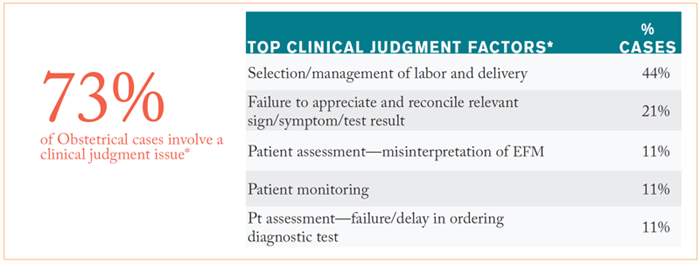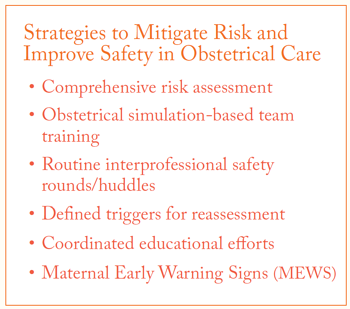The natural process of birth is routinely efficient, and the vast majority of labors end with a healthy mother and child. But when things do go wrong in obstetrics, the reasons are often unclear. Understanding the critical decision points and factors that influence such scenarios is the first step in preventing their recurrence.
Obstetrics leaders who implement risk reduction initiatives based on a single event or without context of other cultural issues at play may be misinformed and misdirected. Analysis of obstetrics-related MPL cases offers an opportunity to proactively identify prevalent risk factors and sharpen the focus for your patient safety efforts.
To identify and understand these risks, we mined our national Comparative Benchmarking System (Candello), a database of deeply coded medical professional liability (MPL) claims. This Candello analysis provides context and insights to health care leaders, doctors, nurses, and other clinical providers who are involved in obstetrical care.
WHAT GOES WRONG IN OBSTETRICAL CARE
In an analysis based on 1,298 MPL cases with claim-made dates from January 1, 2012 through December 31, 2016 with an Obstetrics-related major allegation, delay in treatment of fetal distress was the most common—and costly—allegation.

FACTORS THAT CONTRIBUTE TO OBSTETRICAL INJURIES
Candello enables health care leaders to understand the drivers of harm through the coded contributing factors—actions, or inactions—that led to the event in question. Reflecting the complexity of care delivery, a case will often have multiple contributing factors identified.
In this analysis, the majority of obstetrical claims arise during the second stage of labor, where missteps in judgment and communication can hinder the obstetrical team’s recognition and response to indications of non-reassuring fetal status (NRFS).
Almost 75% of obstetrical cases involve a clinical judgment issue such as a clinician’s failure to appreciate or accurately interpret worrisome electronic fetal monitoring data, which can lead to delayed responses or inappropriate decisions regarding timing and approach to delivery.

Often, the clarity of hindsight in these cases reveals that signs of NRFS were present, but providers isolated in one-on-one labor coaching, or navigating evolving priorities and changing shifts, struggled to maintain the awareness required for accurate decision making.
IMPROVING OBSTETRICAL CARE
 Using data to gain insight about common factors that challenge obstetrical teams is a first step to identifying and understanding your patient safety risks. From here, you can identify targeted risk reduction strategies for your obstetrical unit. But to maximize the success of your improvement efforts, it is critical to understand the culture within which they will become embedded.
Using data to gain insight about common factors that challenge obstetrical teams is a first step to identifying and understanding your patient safety risks. From here, you can identify targeted risk reduction strategies for your obstetrical unit. But to maximize the success of your improvement efforts, it is critical to understand the culture within which they will become embedded.
For instance, simulation-based team training can be highly effective for addressing communication and clinical judgment challenges and can be undertaken in high- or low-fidelity training environments. Both methods help prepare your team for emergency caesarean or post-partum hemorrhage, but which approach is best for your team’s unique needs? Are there cultural dynamics that may impact the effectiveness of your training efforts, regardless of the method you choose? Are there structural issues that may impede the team’s ability to implement or adhere to new processes they develop? Are staff willing to fully engage in your improvement efforts? Or are there barriers that may impact receptivity to your efforts?
Understanding these potential barriers is paramount to creating a successful obstetrical safety strategy—and can be challenging for many organizations. While a self-assessment might provide some top-level insights, it can be difficult to get at the root of sensitive issues. An external risk assessment can help to understand clinical and system vulnerabilities—as well as cultural and leadership factors—that influence individual and team behavior and impact the efficacy of your patient safety efforts.
Conducting a comprehensive risk assessment offers qualitative insights that enable leaders to prioritize and maximize engagement in their obstetrical safety improvement efforts.
For additional data insights, download the full risk report about patient safety risks and opportunities in obstetrical care.
Download the Report* The analysis was based on 1,298 MPL cases with claim-made dates from January 1, 2012 through December 31, 2016 with an Obstetrics-related major allegation.
